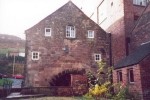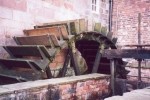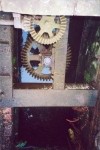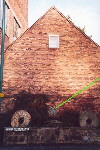![]()
[Home]
To view information about a specific area, click on the relevant link below:
|
Clifton Power Scheme John Heathcote owner of the Clifton Estate between Manchester and Bolton was experiencing problems with his coal mine at Clifton. It was totally drowned out and therefore could not be worked. On his wedding day he heard about Brindley's great ability and made a mental note that maybe Brindley could help him. Time went by and eventually Heathcote did send for Brindley, who then considered the problem of the flooded mine. After studying the plans of the Clifton Estate and the mine for a while, Brindley came up with a solution. His plans were accepted as feasible and after doing a survey, Brindley carried out the scheme in 1752 and the project was completed four years later in 1756. Brindley constructed Ringley Weir and from above this he created a tunnel for the water to flow through. When the water reaches the river Irwell, a vertical pit goes down through a siphon under the bed of the river. It then goes back up to ground level on the other side and along an open channel till it enters the side of the hill and ends in a large chamber where there is a water wheel. Over this length described the river Irwell falls 35 feet, which produced enough power to drive the overshot 30-foot diameter wheel. The powerful river Irwell produced enough energy for Brindley to harness and to use to drive a set of pumps that cleared the mines of water and kept them clear. In 1867 (after 111 years of use) the water wheel was replaced by a water turbine and this was used until a steam pump took its place in 1924. Wet Earth Colliery was closed down in 1929. This project led to Brindley proving himself to be the leading engineer at that time who was not only able to conceive and plan a project, but could also follow it through to completion. No wonder Brindley was nicknamed 'The Schemer'! |
|
Corn Mill at Leek In 1752, James Brindley rebuilt the Leek corn-mill that lies on the river Churnet. The diameter of the water-wheel is 16 feet and it is an 'under shot' type. This means that the drive water passes underneath it. The ground floor of the mill contains the gear wheels that transmit power from the waterwheel to the millstones on the first floor. Also on the first floor is a stone with the inscription T.I. 1752 J.B. confirming that the mill was designed and built by Brindley. The identity of T.I. is not known for sure but is most likely to be the initials of the man for whom the mill was constructed. Corn was ground in the mill until 1944. It was then used as a saw-mill and a garage despite part of it being demolished just after the war for street widening. In 1968 the building was classified as a designated Ancient Monument and it is now listed by English Heritage as of historic importance. The Brindley Preservation Trust (which was set up in 1970) purchased the mill in 1972 and began the process of restoration, which was completed in 1974. It is now a museum that demonstrates Brindley's work both as an architect and as a millwright.
|
|
Windmills and Watermills In 1758 Brindley constructed a windmill at 'The Jenkins', near to where the Burslem Town Hall is now located, for Messrs J and T Wedgwood. Up until this point in time powder was made from calcined flints by pounding them manually in a mortar. As the use of this powder was becoming increasingly popular, Brindley designed this windmill (using revolving arms) to grind the flints into a paste when the flints were put in and covered with water. The reason behind using water in the process was that this eliminated the dust-choked atmosphere that has dangerous consequences. As well as the grinding, the mill also powered a pump in order to obtain the water needed for the process. Unfortunately, when this mill at the Jenkins was first set in motion, the sails were blown off during a high wind! This was one of Brindley's setbacks, but he soon corrected the problem and the mill was worked for many years. The process was so satisfactory that he was called upon by many other people to erect both windmills and watermills. These other mills were constructed in a variety of locations including Trentham, Wheelcock, Metherso, Ashbourne (1755-1757), Tatton, Abbey Hilton, Codan, Congleton, and Leek Corn Mill. The mill at Congleton was to be built by Johnson with the help of Brindley. Brindley received all his directions verbally and was never allowed to see the plans as he was considered by Johnson to be a common millwright. Time proved that Johnson was incapable of completing the work, and the proprietors turned to Brindley for help. Johnson still withheld the plans from Brindley and he therefore started from scratch and designed and built the mill himself. He even made special machines for making the tooth-and-pinion wheels, which had always previously been cut by hand. Brindley even added a few improvements to the mill that led to the proprietors being very content with his work. Brindley's notebooks indicate that even during his canal activities he continued to be busy with mills and other mechanical devices. However, due to the amount of work Brindley did in the area of canals and waterways these other activities were somewhat overshadowed. |
|
Steam Engines The pumping of mines needed a steady amount of power and therefore harnessing the forces of wind or water would not suffice. In 1712, Thomas Newcomen constructed the first steam engine near Dudley. Since then other people had built steam engines of increasing power and now it was Brindley's turn! It appears that he made his first one in 1756 for Mr Thomas Broad of Little Fenton for a colliery there. He was following established practices and it can therefore be assumed that it worked well just like the other engines of the time. Brindley proceeded to attempt to build a steam engine at Fenton Vivian (commissioned by Miss Broad) that lost less heat and was therefore more efficient. He did this by constructing the cylinder out of wood, which is a non-conductor. This engine began its working life on the 19th March 1758 and was supposedly successful in that coal consumption was down by half of that of other engines. However, on the 21st April 1758, about a month after being in use there was a complete breakdown as the wood could not stand up to live steam. We are not exactly sure what happened to this engine, but seeing as it was still in use two years later, the wooden cylinder and piston were probably replaced by cast-iron ones. Brindley also carried out other experiments on boilers. One of these experiments was to construct the boiler out of wood with an internal cast-iron fire-box. This did not work and he then went on to build a boiler made on the arched principal of brick or stone, with the internal fire-box. This was patented on 26 December 1758. Amongst Brindley's engines are the ones that he made in 1759 at Bedworth, Cheadle and Little Wyrley. |







